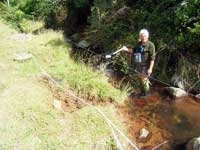The science behind clean waterways

NIWA scientists are leading the way in developing sciencebased solutions for the restoration of New Zealand’s degraded streams, rivers, and lakes. The confidence of landowners and others to act on some key aquatic restoration initiatives has been underpinned by our ‘Restoration of Aquatic Ecosystems’ research programme, funded through the Foundation for Research, Science & Technology.
Local authority and industry restoration projects are becoming more widespread. Success stories include Fonterra’s ‘Dairying and Clean Streams Accord’, and Environment Waikato’s Clean Streams Project, which has seen some 738 km of stream fenced and 239 000 native plants planted in riparian areas on 515 farms since 2002.
In some areas, farmers and environmental care groups are taking the initiative, while in other regions, such as Waikato and Southland, local authorities are supporting landowners to mitigate the effects of farming, forestry, andurban development on water quality. NIWA’s on-going input includes measuring stream water quality, habitat and biota at a selection of ‘Clean Streams’ throughout the Waikato, and at a number of model dairying catchments nationwide.
